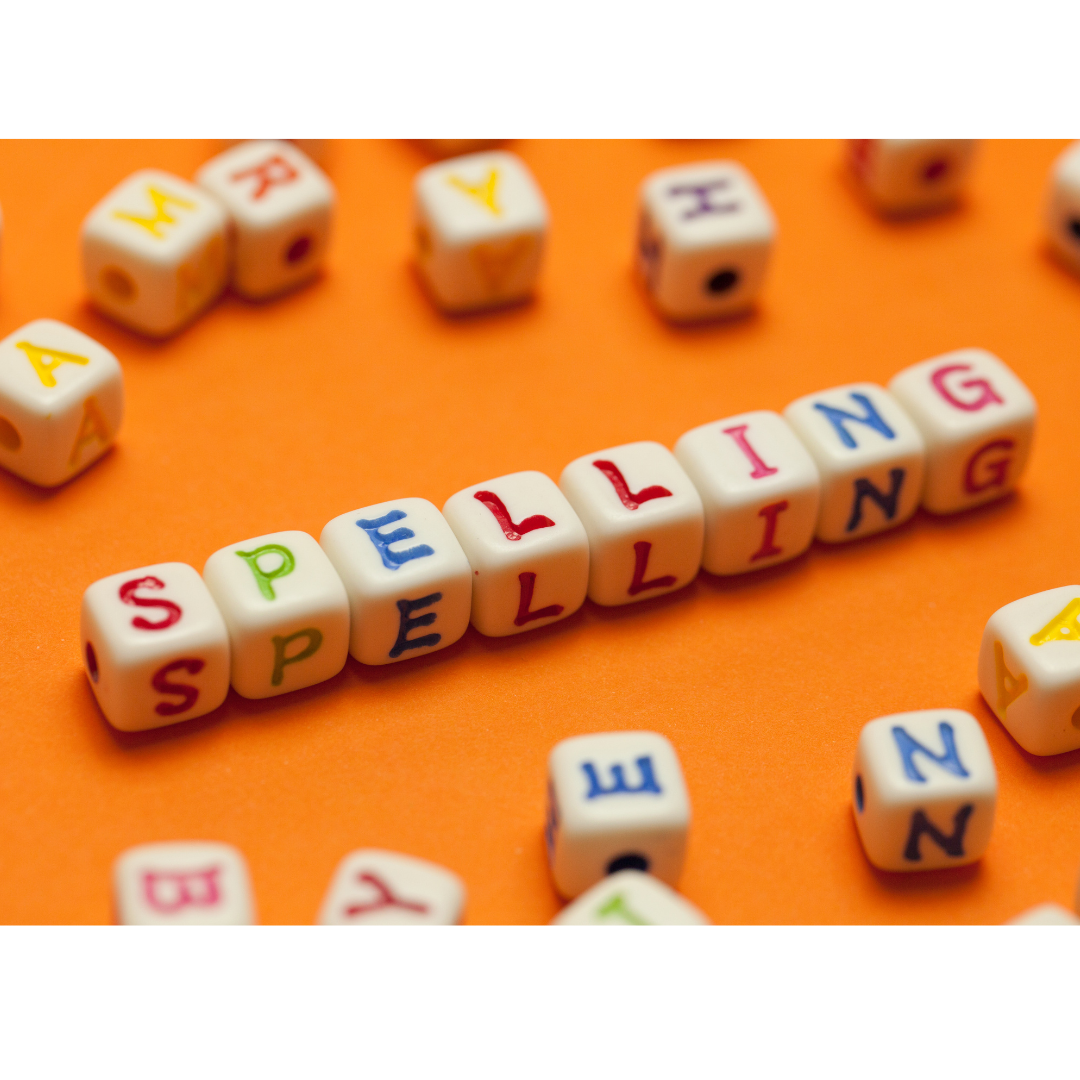This blog article is going to be a bit different because the main part will be a bulleted list of fun ways to practice spelling words. You can just take the list and use the ideas immediately! However, before I launch into the list, I want to be sure you know WHY these ideas make spelling practice both fun AND effective.
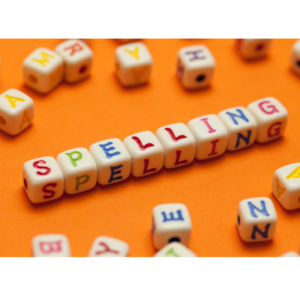
Multisensory learning is all about getting information into the brain via as many sensory inputs modes simultaneously as possible. The most obvious input modalities are Visual, Auditory, Tactile, and Kinesthetic or VATK. Visual is seeing the word – one word at a time. Auditory is hearing and saying the words and letters. Tactile is small motor and skin senses writing and feeling the word. Kinesthetic means large (or gross) motor movements using the large muscles of the body, like running, crawling, reaching, and moving arms and legs. When you try to keep VATK in mind, it is easy to come up with all kinds of ideas for practicing spelling – and math facts! However, there are other senses that can be utilized as well, like taste, smell, and balance.
I won’t go into where words and language are stored in the brain for this post; although, I do want to explain how these input modalities make neural connections between various parts of the brain. By seeing, hearing, and doing something with a word at the same time, taking in the spelling happens in multiple areas of the brain. Retrieval later then becomes a bit easier for students who have language-based learning issues because the brain is able to connect through additional sensory storage systems.
Using VATK can help make spelling practice fun!
For the visual input, that usually includes seeing a word in large, bold letters. I prefer a darker font on a contrasting background. Purple, blue, or red letters on a buff or white background creates imaging in the visual system more effectively than pastel-colored letters or brighter background paper. Mostly, I write one word on an index card as the spelling word prompt.
For the auditory input, the student must hear and say the word and letters or sounds out loud. Saying the word and letters in silly voices can make students laugh, which brings down the anxiety level, and makes recall of the spelling more effective.
For tactile, writing a word three to five times certainly is the traditional route. However, kids with fine motor difficulties are trying so hard to just get the word on paper, that the effectiveness of the repetition becomes more like torture and shuts down the memory systems for spelling. Remember, that we don’t just do tactile sensations by writing with a pencil on paper. The skin on our entire body brings in tactile sensations, so finger writing on an arm or thigh or someone else’s back can help to store the spelling of a difficult word in many areas of the brain. You will see loads of fun tactile spelling ideas in the list. Have fun with them and try not to worry about the mess!
For kinesthetic ideas, we want whole body and large motor movements. Using toes to trace large letters on whole sheets of paper can be more effective than simply copying a word on paper. Any kind of game you can use that has a kid running around to collect letter cards or staying balanced while spelling will make more areas of the brain activate. One homeschool mom friend shared recently that her son likes to practice spelling hanging upside down on the couch. Plus, doing anything with movement is just more fun, so kids want to practice more!
For other senses, like taste and smell, use spices, herbs, colognes, pudding, jello, cookie dough, pickles, play dough, or anything else that has a distinctive smell or taste to incorporate with other senses for spelling. The more senses that are integrated in the fun, the more places in the brain that can assist in recall when a child is writing sentences or paragraphs.
Ideas, Ideas, Ideas!!
OK, now for the ideas! Get ready to have some spelling fun!
Use a purple, blue, or red dry erase marker on a whiteboard.
Use a sand tray. I have posts and videos on social media that show you how to make a sand tray.
Use a rice tray. I have posts and videos on social media that show you how to make a rice tray.
Do shaving cream spelling. Don’t use a wooden table because shaving cream can hard the wood. Squirt a stream of shaving cream in front of each child. Have them use their hands to smear it out and their fingers to write the word in the film that is created.
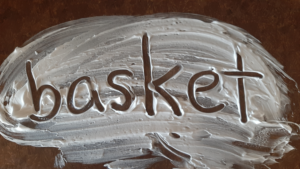
Finger write spelling words on your arm.
Finger write spelling words on your leg.
Finger write spelling words on someone’s back.
Cut out magazine letters. Have the student assemble the words from the different lettering styles and glue them to a piece of copy paper.

Write really large letters on large pieces of copy paper or construction paper. Have the students take their shoes off and trace the letters with their toes. Of course, say the letters or sounds and blend the word aloud at the same time.
Write each letter of the spelling words on an index card. Distribute the letter cards around the family room or backyard. Dictate a word and have the student run around to collect the letters and assemble the word in front of you.
Do sidewalk chalk spelling.
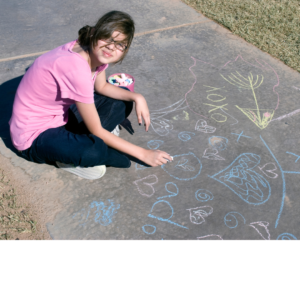
Use brightly colored artist chalks on black construction paper.
Use oil pastels (craypas) to write spelling words on a large 12×18 piece of white construction paper. Use diluted tempera paint or watercolor paints to wash over the spelling words with a darker color so the oil pastel words pop.
Paint spelling words with tempera or watercolor paints.
Make sand letters on small pieces of cardboard. Have the student assemble the cards into a spelling word and trace over the sand letters with their fingers.
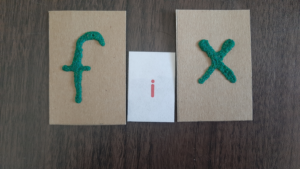
Create you own crossword puzzle. There are free programs online that you can type in your spelling words. Have the students write their own definitions or look them up in the dictionary. (Teacher, have the student do the typing if possible). Then print out your puzzle and have the whole family work on the puzzles.
Have the student “air” or “sky” write their words by swinging their arms really big in the air and move to the shape of the letters.
Have the student write the spelling words on sheets of copy or construction paper. Tape the paper to a tile floor. Have the student hop or jump from word to word and spell the word aloud as they stand on the paper.
Make glue letters on small pieces of cardboard – let them dry so they are bumpy. Have the student assemble the cards into a spelling word and trace over the glue letters with their fingers.
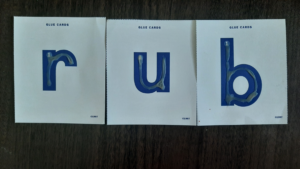
Use letter stickers from the dollar store. Have the student make the spelling words from stickers on an index card or sheet of copy paper.
Use letter rubber stamps and ink pads to stamp spelling words.
Draw lines around a spelling word that is written on an index card. Have the student spell the word aloud while looking at it with the shape around it. Then color in the shape or cut it out. See if the student can recall the word by seeing only the outline shape.
Write each spelling word on a sheet of copy paper with blue, purple, or red Crayola markers. Take a spray bottle of water and your word pages outside. Spray each word until the markers are almost all washed off. Of course, spell and say the letters and each word aloud as your spray. The picture shows a before and after of spray bottle spelling.
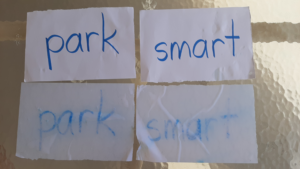
Color water with food coloring and put into a spray bottle or squirt bottle. Go outside in the snow and spray your spelling words. Always, say the letters and the words aloud.
Use letter stencils to trace your spelling words.
Use bulletin board letters to assemble your spelling words on a corkboard or just lay them out on the floor.
Spell your words with scrabble tiles.
Create your own word search puzzle. There are free programs online that you can type in your spelling words. (Teacher, have the student do the typing if possible). Then print out your puzzle and practice finding the words.
Use alphabet macaroni. You know, the kind for alphabet soup. Have the student glue macaroni letters to paper to spell words. If you can’t find alphabet macaroni, have the student write the words in large letters with markers and glue regular elbow macaroni on top of the letters. These are fun to spray paint gold or silver!
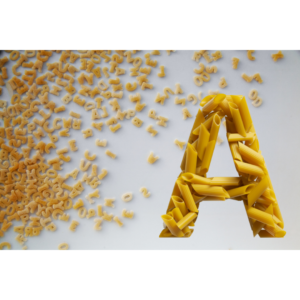
Use alphabet beads to have the student string words on a necklace or bracelet.
Write each letter of a spelling word on a half sheet of copy paper. Prop or tape each letter to the vertical part of stairs going up and the whole word on the top step to see. Have the student jump up (or walk if safer) each stair and say the letter, spelling and saying the word when they reach the top.
Have the student stand on a balance beam, tape line, or balance apparatus. Show a spelling word on a card and have the student spell the word aloud while walking heel to toe or staying balanced.
Have the student sit in a swivel office chair. Show a spelling word and have the student spin in the chair while spelling the word aloud. If your child gets too dizzy with this activity, choose a different one.
Have the student look at a spelling word on an index card, hang upside down on a couch or playground pipe and spell the word aloud.
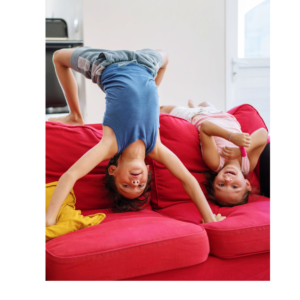
Write a spelling word on an index card or copy paper. Give the student one to three colors of tempera paint and a few q-tips. Have the student paint the letters with q-tip dabs.
Use bingo markers (Do-a-Dot dabbers) to create spelling words on a 12×18 sheet of construction paper.
If you have a microfiber or textured couch or chair, have the student look at a spelling word on a card and finger write on the seat of the chair. You can also do this on carpet.
If you have bubble wrap from a delivery, have the student finger write spelling words on the bubble wrap. Then pop it, of course.
Provide a cookie sheet and waxed paper or parchment paper. Have the student spell words with frosting with cake decorating tools.
If you live near a lake or the ocean, do beach spelling with a stick.
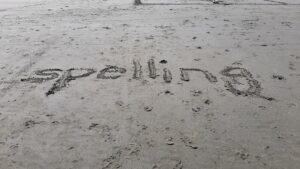
Make a jello sealed plastic bag. You can secure the open end with duct tape if needed. Have the student finger write a spelling word on the outside of the plastic bag.
Make homemade play dough, cinnamon ornament dough, or just regular play dough. Have the student roll out dough snakes and form the letters to spell out a spelling word.
Use bathtub paints and have the student practice spelling words in the the bathtub.
Give the student an eye dropper or science pipette. Write a spelling word on an index card. Place the index card under a clear plate or tempered glass shelf. Have the student form the letters by dropping water from the eye dropper.
Have the student write with “invisible ink” (aka lemon juice) on a piece of paper. Together check the spelling by holding the paper over a burning candle to reveal the “secret message.” NOTE: this one should be completed with adult supervision!
Use homemade, regular play dough, or nonhardening plasticene clay and smear it all over a medium sized cardboard. Have the student “etch” spelling words into the smeared out clay with a toothpick, kabob skewer, or plastic fork.
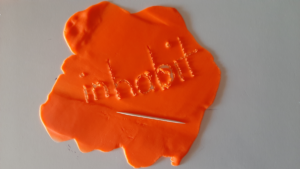
Use alphabet cookie cutters to make spelling words in to cookie or to make with play dough.
Have the student copy spelling words on a mirror or window with washable paints or dry erase markers.
Have the students lie down on the floor in a darkened room with a flashlight. Dictate a spelling word and have the student spell the word on the ceiling with the flashlight.
Give the student a newspaper or magazine article. Have the student circle spelling words or common sight words in the article.
Write a word on an index card. Pour iron filings on a cookie sheet. Have the student use a bar magnet underneath the cookie sheet to “write” the word. The iron filings will gather around the magnetic field. If the filings get mixed up, have the student drag the magnet for each letter and pull away between the letters.
Have the student build spelling words from candy corn pieces, M&M candies, raisins, cereal pieces, marshmallows, and more!
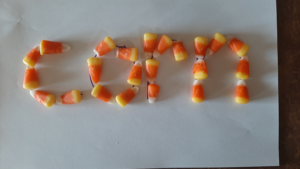
Even if you use only a few of these ideas, your kid is going to be begging to do spelling every day! And you will know that the practice will be brain-friendly and more effective than copying words three to five times. Have fun spelling!
